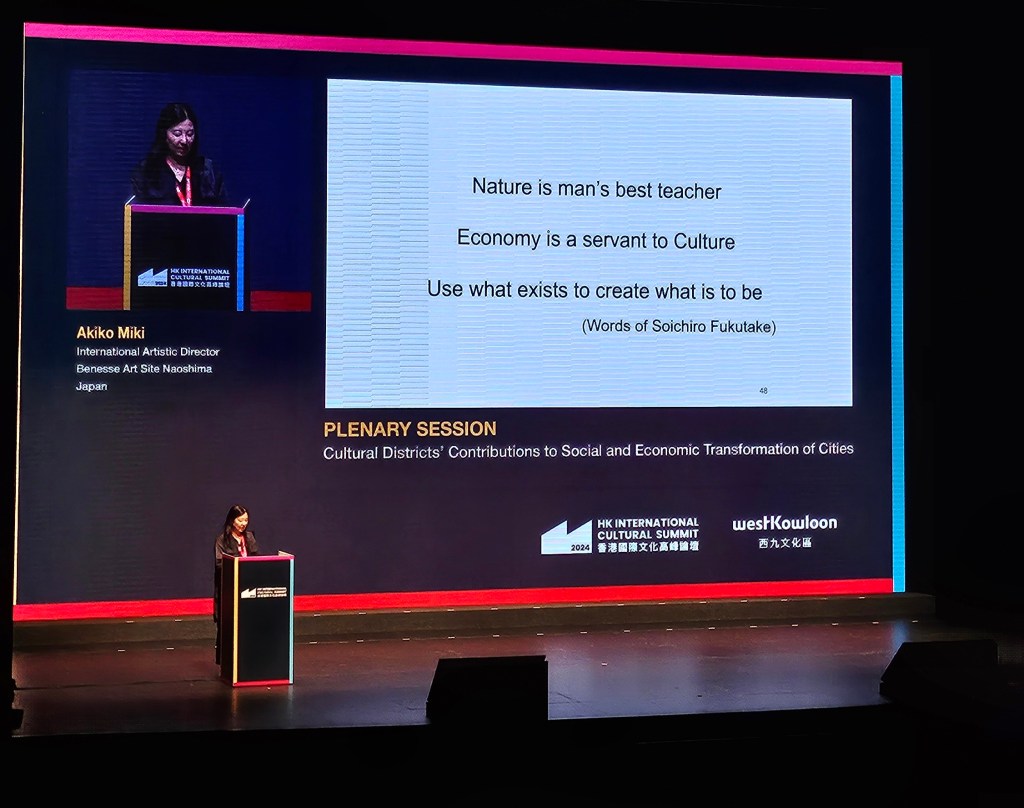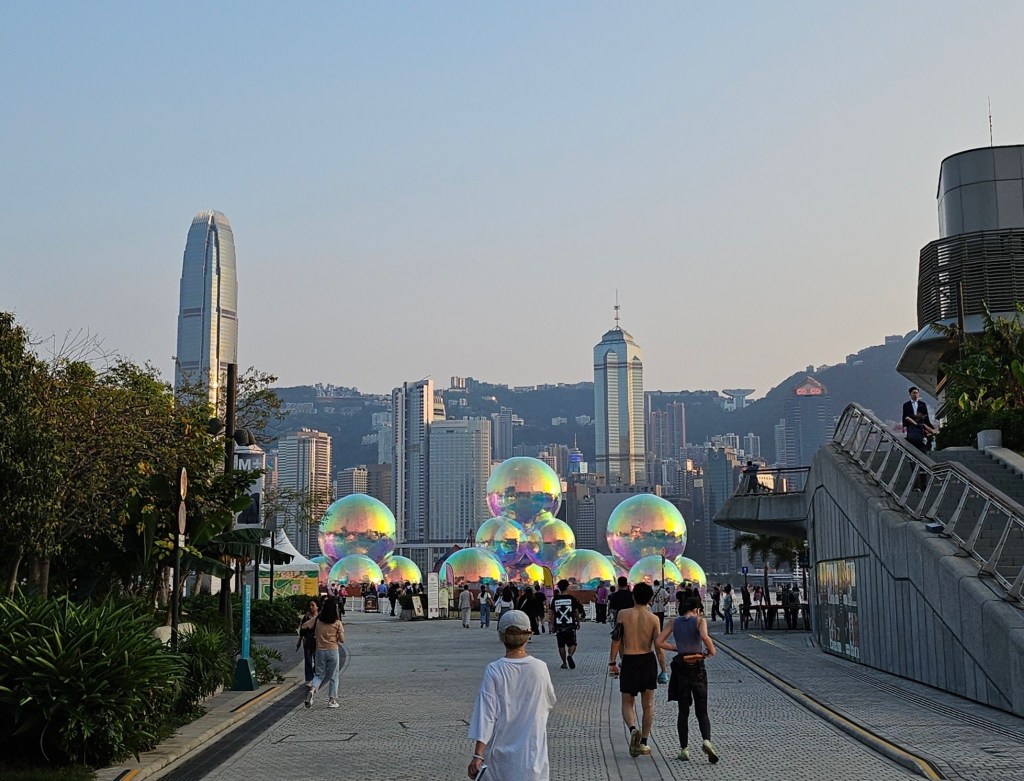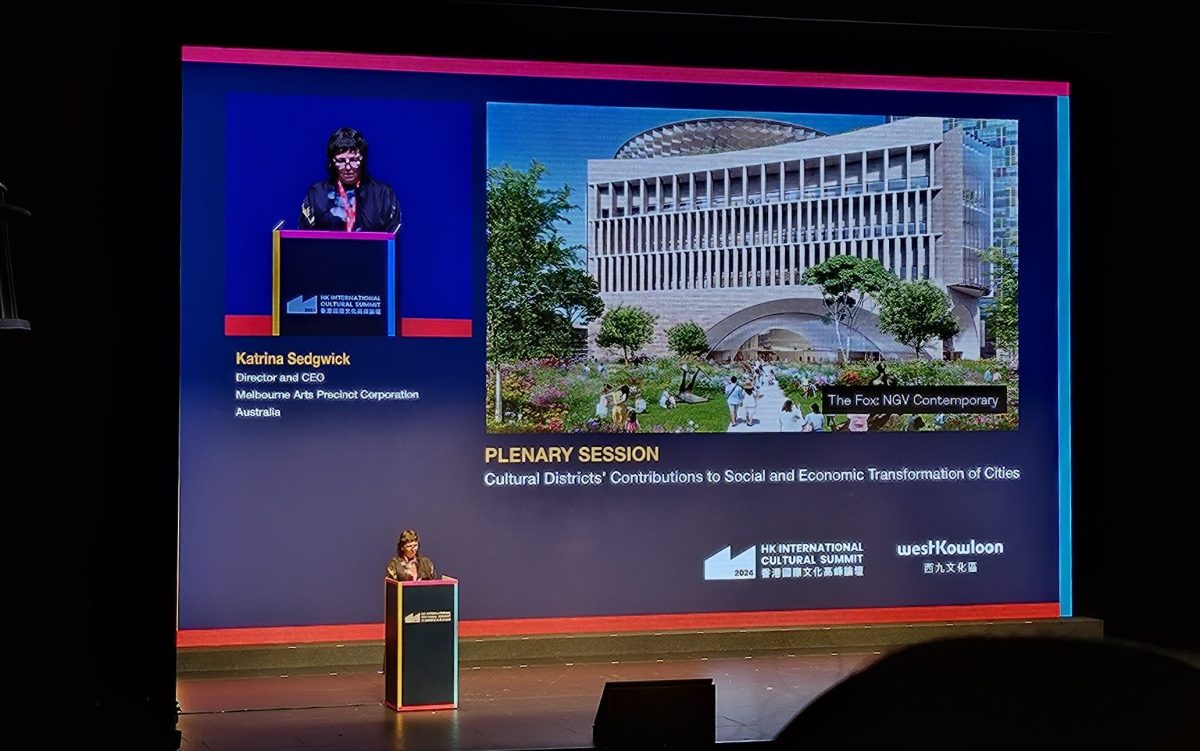Arts precincts are characterised by a large stretch of land that features several major institutions across art forms, alongside tenants and independent organisations under one cohesive umbrella or vision. Perhaps more strategically than coincidentally, they are often on the waterside and create pockets of public space where art, leisure, food, entertainment and cultural tourism ideally work in harmony.
The last decade has seen a steady rise of cultural precincts. In 2014, Adrian Ellis, Director of Global Cultural Districts Network (GCDN) predicted that over US$250 billion (GBP£197 billion) would be invested into new developments in the next decade… and here we are.
Hong Kong’s West Kowloon Cultural District (WKCD) has been a major development project in the last 15 years, but the vision for a new arts precinct in Hong Kong was birthed almost 30 years ago. WKCD is said to be one of the largest cultural precincts in the world, with the HKSAR Government allocating a 40-hectare waterfront site and HK$21.6 billion (£1.8 billion) upfront.
Currently completed landmark institutions include the Xiqu Centre that opened in 2019, followed by M+ in 2021 and Hong Kong Palace Museum in 2022. The Lyric Theatre Complex under development will set a stage for local and international acts.
As the project progresses, WKCD has been tapping into examples of forerunners from different cities and regions that have established art precincts of scale and large visitation, or are also on the path to further development.
At the inaugural Hong Kong International Cultural Summit (HKICS) (24-26 March), four global arts precincts were brought into focus at the Plenary Discussion, featuring East Bank (London), Melbourne Arts Precinct Transformation (MAPT), Benesse Art Site Naoshima (Japan) and Museum of Islamic Art (Doha, Qatar).
All case studies utilise large stretches of land that were either previously barren or “cultural deserts” to create spaces for the arts that engage with their surrounding communities and the public. Common topics of discussion include access, tourism, funding, sustainability, and international and community engagement.
Read: What makes an arts precinct?
MAPT builds upon the existing infrastructure of Melbourne’s Southbank, which currently includes the National Gallery of Victoria (NGV), Arts Centre Melbourne, Victoria College of the Arts (VCA), Australian Centre for Contemporary Art (ACCA), Melbourne Recital Centre, Melbourne Theatre Company and more. It aims to connect Southbank with Federation Square, which houses The Ian Potter Centre: NGV Australia, Koorie Heritage Trust and Australian Centre for Moving Image (ACMI), along with major infrastructure developments including The Fox: NGV Contemporary and the Arts Centre upgrade.
One of the criticisms that Southbank’s art landscape received early on was the sense of institutions in isolation, each hoarding their group of visitors inside concrete spaces that don’t offer broader connection. This is hoped to be remedied by improving the public experience at street level with activations, such as public art and green spaces, explained Melbourne Arts Precinct Corporation Director and CEO Katrina Sedgwick at Monday’s (25 March) HKCIS Plenary Discussion. The Urban Garden development will begin in late 2026, occupying the space between NGV International and The Fox: NGV Contemporary, as well as wrapping around Arts Centre Melbourne. It will feature 18,000 square metres of what Sedgwick called ‘Australian naturalism’ and ‘is going to be an artwork in and of itself’.
The current demolition of 77 Southbank Boulevard (the former Carlton United Brewery Building) to make way for Fox: NGV Contemporary is also one of “deconstruction” rather than “construction”, Sedgwick added. The project aims to recycle and reuse 95% of existing building materials.
In a landscape where both institutions and artists heavily rely upon government and council funding, Federation Square instead relies on rental income from tenancies and commercial and event partnerships to maintain its operations.
Self-sustaining operations for an arts institution or precinct are something that all aspire to, but this doesn’t mean public funding can simply withdraw. Tim Reeve, Chair of East Bank Board and Deputy Director and Chief Operating Officer of Victoria and Albert Museum, London said, ‘[A cultural precinct] requires ongoing investment from the public purse, but combined with more of an entrepreneurial spirit across the park.’
It’s also important to consider a precinct as a whole ecosystem, continued Reeve. Sometimes this involves an identifiable brand and, in other instances, it’s about it being seamlessly embedded into the everyday lives of people in the surrounding areas and those who frequent the space – including commuting workers, residents and students etc.
When it comes to public engagement, it’s not only visitation that counts, but also the amount of time that people spend in the precinct and the kind of activities they engage in.
For International Artistic Director of Benesse Art Site Naoshima, Akiko Miki, working with local residents on the island involved years of trust-building. Benesse Art Site Naoshima is based on the islands of the Seto Inland Sea with a population of just over 3000. The land was once scarred by pollution from copper mines, but is now home to an array of museums designed by Japanese architect Tadao Ando, as well as pop-up exhibitions in local houses.
Miki explained, ‘Having this long-term vision is quite important for this kind of cultural development project… The purpose of what we’re doing is not we’re making them come [to the art site] – it’s actually their land, their community and what we’re doing is make local people regain pride [in] that.’

Sedgwick also shared this perspective of fostering cultural pride and building upon the identity of a place. ‘Our job is to glue this precinct together and weave it into the fabric of the city to harness the opportunities now,’ she said. ‘This multidimensional project has so many partners and opportunities if we harness them clearly through strategic thinking, advocacy, new ways of working together.
’Crucially, we’re taking a user experience design approach to consider the visitor journey right across the precinct. And it’s through this lens that we explore physical and digital holistic way-finding, lighting, collaborative programming, activation, marketing and communications, ticketing; we’re looking at public transport for identifying food and beverage opportunities, and much more.’
Zooming out to look at the connection between cultural arts precincts globally, different forms of collaboration are already underway, with WKCD establishing Memoranda of Understandings with 21 arts and cultural institutions and looking at exchange programs for local and international artists.

Chief Executive of the Hong Kong Special Administrative Region, John KC Lee, also expressed his hopes for the city’s newest cultural development. ‘Hong Kong is the only city in the world that enjoys both the China advantage and the global advantage,’ he said during the opening remarks of HKICS. ‘That’s why we’re committed to capitalise on our unparalleled advances to develop Hong Kong into an “East meets West” centre for international cultural exchange – a commitment that enjoys the full support of our country under the National 15th Five-Year Plan [of China].
’I welcome your arts and cultural groups and artists to perform in Hong Kong, and in doing so, to experience all that Hong Kong has to offer,’ added Lee.
The Hong Kong International Cultural Precinct was held from 24-26 March.
ArtsHub travelled to Hong Kong as a guest of the Government of the Hong Kong Special Administrative Region’s Sponsored Journalist Programme.





